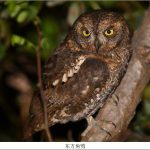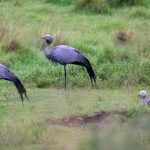An article in the New York Times details the discussion about tropical “secondary” forests, that is, rainforest growing on land that had been cleared for agriculture or logging that is reverting to nature. Are such second-growth rainforests a replacement for rainforest still being logged or is it less valuable in terms of species diversity?
Recent Posts
 Three Photos: Yellow-eyed Owls in ShanghaiBy Editor
Three Photos: Yellow-eyed Owls in ShanghaiBy Editor The Little BustardBy Clive Finlayson
The Little BustardBy Clive Finlayson Birding Kruger National Park – SkukuzaBy Luca
Birding Kruger National Park – SkukuzaBy Luca Daybreak at the OasisBy Tom Brown
Daybreak at the OasisBy Tom Brown In search of the Citril FinchBy David T
In search of the Citril FinchBy David T Podcast: Hannah and Erik Go Birding; Tala Game Reserve & WakkerstroomBy Hannah
Podcast: Hannah and Erik Go Birding; Tala Game Reserve & WakkerstroomBy Hannah Species Spotlight: Great Grey OwlBy Kai Pflug
Species Spotlight: Great Grey OwlBy Kai Pflug
Welcome to 10,000 Birds!
Learn about our site and writers, advertise, subscribe, or contact us. New writers welcome – details here!
Posting Calendar
| DAY | WRITER(S) | SERIES |
|---|---|---|
| MON | Kai (w) | Birding Lodges (w) |
| TUE | Donna (m) Susan (m) Hannah (m) Fitzroy (m) | Bird Guides (w) |
| WED | Leslie (bw) Faraaz (bw) | Ask a Birder (w) |
| THU | Paul (w) | Birder’s Lists (w) |
| FRI | David (w) | Species Spotlight (w) |
| SAT | Peter (bw) Luca (bw) | From the Archives (w) |
| SUN | Clive (w) Valters (bw) | Three Photos (w) |
| w weekly, bw biweekly, m monthly | ||
| Any time: Jason, Mark, John, Sara, Rolf, Dragan | ||
See here for info on the writers.
Newsletter
Signup and receive notice of new posts!
Thank you!
You have successfully joined our subscriber list.











Forest recovery is a very interesting phenomenon, but as it turns out, it is also a very complicated and local process… In PR, for example, forest structure is recovered in about 40 years. Species diversity and composition of both floral and faunal elements is highly variable, depending on the pre-recovery land use and its intensity, as well as other factors…
The thing is, I don’t think there’s an universal answer to that question! This is a link to an article that studied this processes in PR: http://www.fs.fed.us/global/iitf/pubs/ja_iitf_2003_grau001.pdf
In PR more than 90% of our forests are secondary, as most of the island was deforested during the first half of the 20th century…
I know that in temperate forests, cut-and-regrown forests can actually support more biodiversity than old growth forests. Older forests have very little vegetation on the ground, because the majority of sunlight is taken by the broad reach of tall, old trees. New forests (regrowing from cut, fire, etc) start with shrubs and berry bushes, and move to fast growing trees. Each of these stages support wildlife that can’t necessarily live in an old growth forest. I don’t know if second-growth rainforests work the same way, but I think that any forest is better than no forest.
There is also the view that while forests as a whole may recover, the tree and associated faunal composition could be vastly different, especially as many forests, even protected ones, in Asia now have little or no megafauna (elephants, rhinos, great apes, hornbills) and other animals that disperse large-seeded trees (e.g. those in the mango, fig and nutmeg families). Wind- or small animal-dispersed trees might become more dominant. But as trees are long lived, signs of their propagative decline and population dynamics could require studies beyond the lifetime of a single biologist…